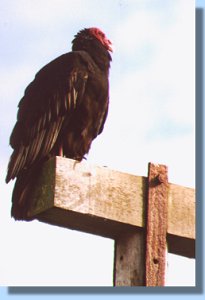 Today the first (and last!) dry landing we'll get on this expedition: West Point
Island. The weather looks promising again and a zodiac quickly brings us to
the shore next to a small settlement. A cottage with a brightly colored red
roof draws our attention.
Today the first (and last!) dry landing we'll get on this expedition: West Point
Island. The weather looks promising again and a zodiac quickly brings us to
the shore next to a small settlement. A cottage with a brightly colored red
roof draws our attention.
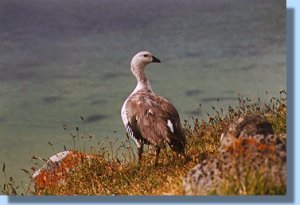
On a pole behind it a turkey vulture is sitting watching the scene. While I'm preparing to make a picture of the read headed bird a Johnny Rook, or striated caracara lands on the pole. Although it's considerably smaller than the vulture, it succeeds in chasing the bigger bird away. Walking back we pass several upland geese.
In the meantime our fellow travelers have disappeared towards the other side of the island. We also start walking to the interior of the island. Soon we've left the last buildings behind and not much later all signs of civilization are gone. The track winds uphill through green gentle sloping fields dotted with mosses and lichen covered rocks. The track is sometimes difficult to follow.
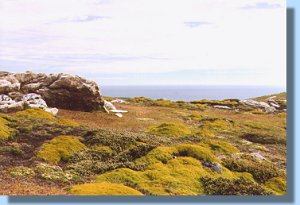
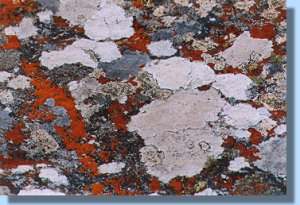 In the meantime the sun has vanished behind some clouds, the temperature
drops and the hilltop in front of us becomes covered by fog. Let's hurry.
In the meantime the sun has vanished behind some clouds, the temperature
drops and the hilltop in front of us becomes covered by fog. Let's hurry.
Just when the track disappears completely we see somebody standing in the distance. No doubt that's the right spot. And indeed we've reached the rockhopper and black-browed albatross colonies of Devil's Nose.
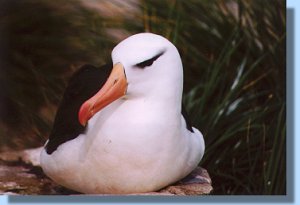
The colonies are surrounded by high tussock grass. The going is tough due to the low lying muddy trails that are hidden between the high grass. One bad step may result in a broken ankle or a flat penguin as penguins use these trails to move from their colony to the seaside. With too many people in too small an area I decide to try to get downhill. There it's much quieter and I enjoy the sounds coming from the colony.
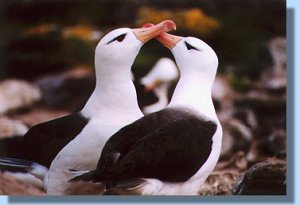
In front of me a pair of black-browed albatrosses are busy displaying. Walking around each other, pointing their necks towards each other and frequently touching their bills against each other they are busy establishing a bond as a couple. Many other albatrosses already found a mate and the area is covered by many nests. Though less abundant down here, there are still quite some rockhoppers present inside the albatrosses' colony.
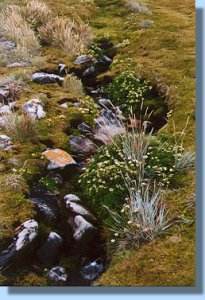
Walking upward I carefully try to avoid the muddy trails but cannot help scaring two rockhoppers that suddenly see a giant thing (me) blocking their path. With a little backtracking I manage to walk around them avoiding further disturbance.
Fortunately the fog didn't come down any further and the visibility remains good. The pleasant hike back is only disturbed by the frequent horn blows of Mrs. Napier's old landrover which is being used to shuttle back some people that are not willing to walk back the three kilometer track. At low tide the pier is much more slippery than this morning but we manage to get aboard safely for our lunch. As soon as everybody is on board we're heading for Carcass Island, our afternoon's stop.
Two hours later we reach Leopard Beach, a sandy beach on the south end of Carcass Island. A few Commerson's dolphins appear, apparently attracted by the noise of the zodiac's engines. Every time a new zodiac delivers its load of tourists it is accompanied by these black and white animals riding the zodiac's waves. They really seem to like it and for quite some time after the last zodiac arrived they can be seen swimming in front of the beach as if waiting for more.
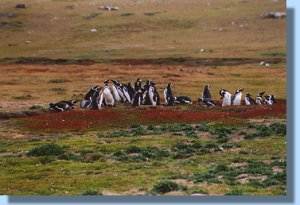
Two rows of low dunes separate the beach from the rest of the island. A green grassy plain with in the middle a small lake lies behind it. Both around the lake and on the beach many upland geese can be seen.
More special at the moment is the sight of our first magellanic penguins. It's a group of about twenty penguins with both adults and chicks. Although our distance is well over 5 meters they seem to be shyer than the rockhoppers we saw before.
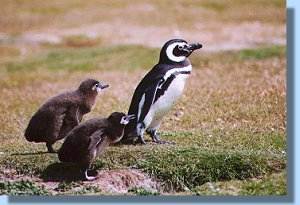
Magellanic penguins lay their eggs in burrows in the ground. One of these burrows becomes the focus of our attention when an adult penguin is chased by its offspring. It's pretty hilarious to see the two chicks stumble over each other or their parent in a frantic effort to get some food. Even a fall in the burrow only stops the chase for a few seconds. It's difficult to stop watching this show but there are more things to see.Several skuas with chicks for example.
On my way to the other side of the island, I cross an area with high tussock grass. Suddenly I'm standing face to face with a pair of magellanics. Frightened they run away, partly on their feet partly tobogganing. A second encounter with a magellanic is different. This penguin isn't scared at all. Instead it watches me with curious eyes. After examining each other for a while we both continue our way.
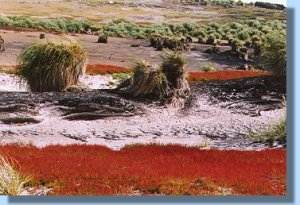
Outside of the tussock grass I'm walking through a sandy area covered with bright red weed. A snipe walks by but it's gone before I'm able to make a picture of it. A little further I reach the beach again. In three separate places magellanic penguins can be seen returning from the sea. But they're extremely shy. Whenever I come closer than about fifty meters they start running towards the sea and disappear in the waves. And worse, they don't return. After about half an hour waiting, I give up and walk again back to the other side.
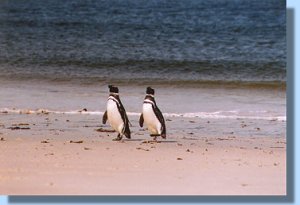
Back on our landing side there's also a large group of magellanic penguins returning from the sea. Although this group is shy as well, they don't immediately disappear in the waves whenever somebody gets close. Instead they run back and forth every time somebody passes. We sit down watching this for a while. Although some people seem to be ignorant of their effect on the penguins fortunately most do walking around the penguins in a wide circle.
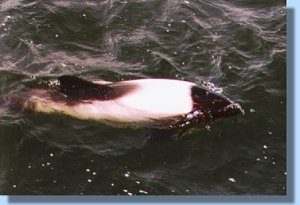
When the first people are being shuttled back towards the ship the Commerson's dolphins suddenly appear again. Apparently the noise of the engines tells them that the fun is about to start again. At first there are only two dolphins. When it's our turn to go back to the ship already six dolphins are following us jumping in the waves behind the zodiac. They have to swim fast to keep up with us but it doesn't seem to bother them. Sometimes they're even within reaching distance. They accompany us right to the ship.
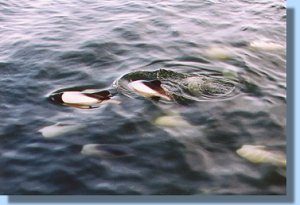
From the bow of the ship many more dolphins can be seen swimming around. I count at least twenty dolphins. Every time a zodiac comes close some of the dolphins race towards it. Doug is so enthusiastic that he can't stop when he reaches the ship. Instead he drives his zodiac around the ship three times with a number of dolphins in his trail. When the last zodiac has arrived the party is over and slowly, as if they still hope for more, one by one the dolphins swim away. This second day of our trip again was an exciting one.